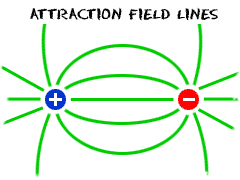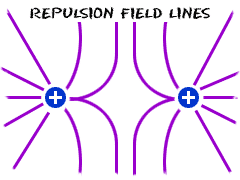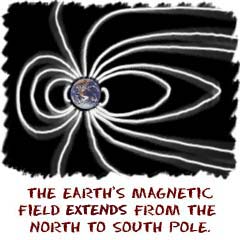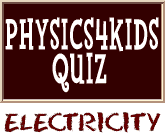Magnetic Field Basics
 Magnetic fields are different from electric fields. Although both types of fields are interconnected, they do different things. The idea of magnetic field lines and magnetic fields was first examined by Michael Faraday and later by James Clerk Maxwell. Both of these English scientists made great discoveries in the field of electromagnetism.
Magnetic fields are different from electric fields. Although both types of fields are interconnected, they do different things. The idea of magnetic field lines and magnetic fields was first examined by Michael Faraday and later by James Clerk Maxwell. Both of these English scientists made great discoveries in the field of electromagnetism.
Magnetic fields are areas where an object exhibits a magnetic influence. The fields affect neighboring objects along things called magnetic field lines. A magnetic object can attract or push away another magnetic object. You also need to remember that magnetic forces are NOT related to gravity. The amount of gravity is based on an object's mass, while magnetic strength is based on the material that the object is made of.
 If you place an object in a magnetic field, it will be affected, and the effect will happen along field lines. Many classroom experiments watch small pieces of iron (Fe) line up around magnets along the field lines. Magnetic poles are the points where the magnetic field lines begin and end. Field lines converge or come together at the poles. You have probably heard of the poles of the Earth. Those poles are places where our planets field lines come together. We call those poles north and south because that's where they're located on Earth. All magnetic objects have field lines and poles. It can be as small as an atom or as large as a star.
If you place an object in a magnetic field, it will be affected, and the effect will happen along field lines. Many classroom experiments watch small pieces of iron (Fe) line up around magnets along the field lines. Magnetic poles are the points where the magnetic field lines begin and end. Field lines converge or come together at the poles. You have probably heard of the poles of the Earth. Those poles are places where our planets field lines come together. We call those poles north and south because that's where they're located on Earth. All magnetic objects have field lines and poles. It can be as small as an atom or as large as a star.
Attracted and Repulsed
You know about charged particles. There are positive and negative charges. You also know that positive charges are attracted to negative charges. A French scientist named Andre-Marie Ampere studied the relationship between electricity and magnetism. He discovered that magnetic fields are produced by moving charges (current). And moving charges are affected by magnets. Stationary charges, on the other hand, do not produce magnetic fields, and are not affected by magnets. Two wires, with current flowing, when placed next to each other, may attract or repel like two magnets. It all has to do with moving charges.Earth's Magnetic Field
 Magnets are simple examples of natural magnetic fields. But guess what? The Earth has a huge magnetic field. Because the core of our planet is filled with molten iron (Fe), there is a large field that protects the Earth from space radiation and particles such as the solar wind. When you look at tiny magnets, they are working in a similar way. The magnet has a field around it.
Magnets are simple examples of natural magnetic fields. But guess what? The Earth has a huge magnetic field. Because the core of our planet is filled with molten iron (Fe), there is a large field that protects the Earth from space radiation and particles such as the solar wind. When you look at tiny magnets, they are working in a similar way. The magnet has a field around it.
As noted earlier, current in wires produces a magnetic effect. You can increase the strength of that magnetic field by increasing the current through the wire. We can use this principle to make artificial, adjustable magnets called electromagnets, by making coils of wire, and then passing current through the coils.
Or search the sites for a specific topic.
- Overview
- Charges
- Conductors
- Electric Fields
- Magnetic Fields
- Current
- Resistance
- Faraday's Law
- Coulomb's Law
- Magnets
- DC Power
- AC Power
- More Topics

Solar Particles and Earth’s Magnetic Field (NASA Video)

Useful Reference Materials
Encyclopedia.com (Electromagnetic Field):http://www.encyclopedia.com/topic/Electromagnetic_fields.aspx
Encyclopedia.com (Magnetic Field):
http://www.encyclopedia.com/topic/Magnetic_Field.aspx
Wikipedia:
http://en.wikipedia.org/wiki/Magnetic_field
Encyclopædia Britannica:
http://www.britannica.com/EBchecked/topic/357048/magnetic-field





